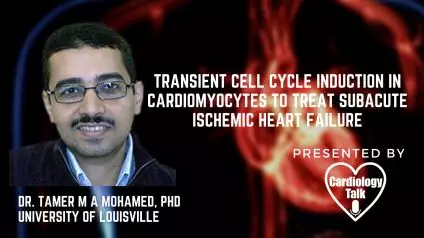Dr. Tamer M. A. Mohamed, PHD- Transient Cell Cycle Induction in Cardiomyocytes to Treat Subacute Ischemic Heart Failu...
Dr. Tamer M.A. Mohamed's works as Assistant Professor of Medicine at the University of Louisville. His research has focused on innovative mechanisms and therapeutics for cardiac hypertrophy and heart failure in animal models for the past 12 years. Translation of those results into human medication therapy for cardiac disease is one of Dr. Mohamed's primary focuses. In this video Dr. Mohamed discusses the Transient Cell Cycle Induction in Cardiomyocytes to Treat Subacute Ischemic Heart Failure.
https://www.researchgate.net/publication/358010698_Transient_Cell_Cycle_Induction_in_Cardiomyocytes_to_Treat_Subacute_Ischemic_Heart_Failure
Background: After a myocardial infarction (MI), the heart's regeneration ability is impaired. In vitro and in vivo, ectopic introduction of Cdk1/CyclinB1 and Cdk4/CyclinD1 complexes (4F) stimulates cardiomyocyte proliferation in 15-20% of infected cardiomyocytes and improves cardiac function after MI in mice, according to a prior study. Methods: On a single cell level, we used temporal single-cell RNAseq to identify the essential reprogramming steps during 4F-induced cardiomyocyte growth. We also hoped to begin the first preclinical testing of 4F gene therapy as a candidate for the treatment of ischemia-induced heart failure utilizing rat and pig models of ischemic heart failure. Results: At 48 hours after infection with 4F, full cell cycle reprogramming was observed in 15% of the cardiomyocyte population, which was primarily associated with sarcomere disassembly and metabolic reprogramming (n=3/timepoint/group), as revealed by temporal bulk and single-cell RNAseq and further biochemical validations of mature hiPS-CMs treated with LacZ or 4F adenoviruses. A polycistronic non-integrating lentivirus (NIL) expressing 4F was used to achieve transient overexpression of the protein in cardiomyocytes. Each NIL is directed by the TNNT2 promoter (TNNT2-4Fpolycistronic-NIL). In rats (n=10) and pigs (n=6-7), TNNT2-4Fpolycistronic-NIL or control virus was administered intramyocardially one week after MI. TNNT2-4Fpolycistronic-NIL-treated animals demonstrated a substantial improvement in left ventricular ejection fraction and scar size four weeks after injection when compared to control virus-treated animals. Rats given TNNT2-4Fpolycistronic-NIL demonstrated a persistent improvement in cardiac function four months following therapy, with no signs of cardiac arrhythmias or systemic carcinogenesis (n=10/group). Conclusions: Using an unique transitory and cardiomyocyte-specific viral construct, this study gives mechanistic insights into the process of forced cardiomyocyte proliferation and increases the clinical practicality of this technique by limiting the carcinogenic potential of cell cycle factors.




